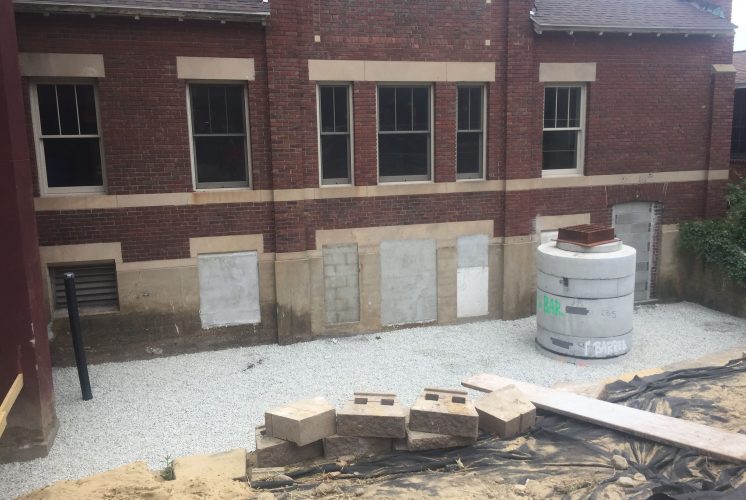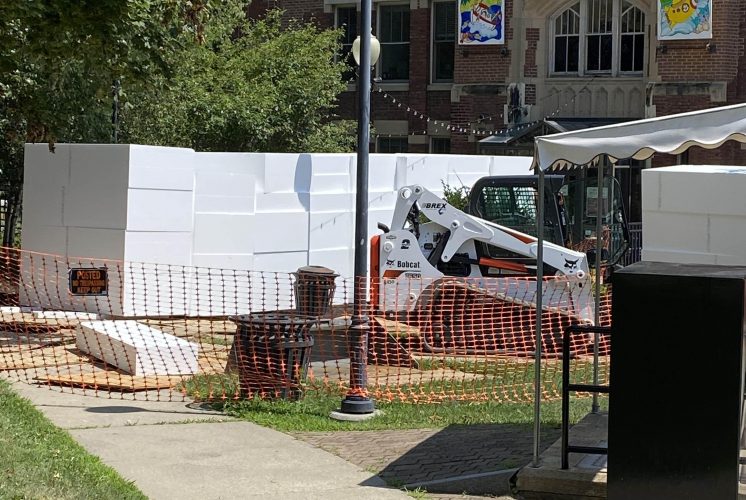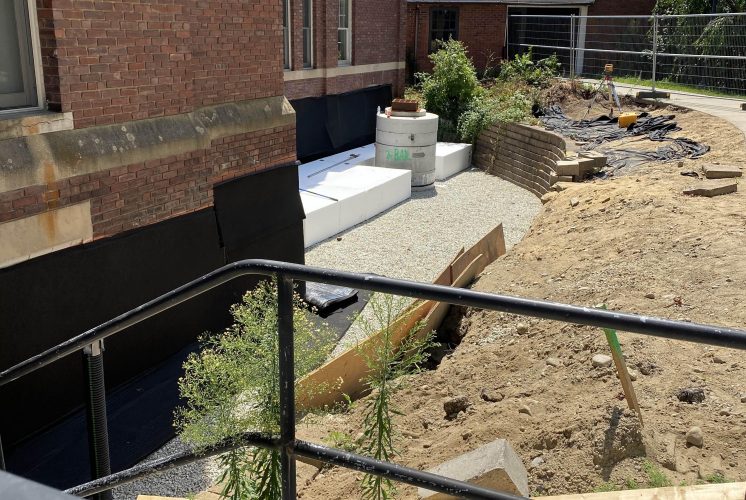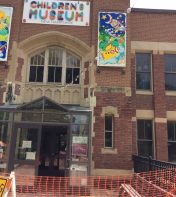Witchway Games & Eric Streed
Q&A with Artist and Game Designer Eric Streed
Q. How do you start making board games?=
A. I would start by playing lots of different board games! Find out what kind of games you like, and what about those games you enjoy. Is it the theme? Do you like drafting cards? Do you like worker placement? What parts of those game maximize on that sort or play?
After you’ve started thinking about those questions, start small. Make an “expansion” to a game you already know and love. Change a rules set, or get some cheap custom cards made for it. See how the rules you change or the elements you implement add to or subtract from the game.
Game design is a skill that takes practice to get better at, your first game is not going to be perfect. Instead of perfect, focus on “Done”. The artist Jake Parker spreads the message “finished, not perfect”. This idea encourages to complete a project, and then start the next one and make it even better. Consider the table presence of the game you want to make, think of that peak moment you want to give a player, and build towards that.
Q. How did you start making board games?
A. I went to school for art, focusing on video game design. I worked for animation studios and on independent video games for a while but found the process slow and unfulfilling. I ended up co-founding a small company a few years after college and got involved making board games and immediately saw a shift. I could quickly hold my game in my hands and play it with other people. The efficiency, community, and tactile nature of board and card games really rekindled my love of game design.
Q. What is the hardest part of making board games?
A. For me the hardest part of game design is iterating. I get an idea, work with people to iron out the details, do the art for the game, get a prototype made up, and start playtesting, only to start finding issues in the design. This is a super normal part of the design process, no game is going to work perfectly right out the gate. This is the piece of the puzzle that gets very granular though, where you are fiddling with numbers, changing rules occasionally, altering the setup and win conditions. This is a crucial piece of the design process, but its also challenging as it also takes the most time.
Q. What resources are there out there for aspiring board game designers?
A. There are lots of great resources for game designers out there! There are social media groups, there are cheap game design kits available online, I’ve even hand cut cards and drawn on them for perfectly functional prototypes. After you have spent a little time making some handmade prototypes or printing some small assets for an expansion to a game you like, using a company like The Game Crafter is a great way to step up your designs and create some really beautiful production quality copies of your game.
CMNH To Re-Open in September
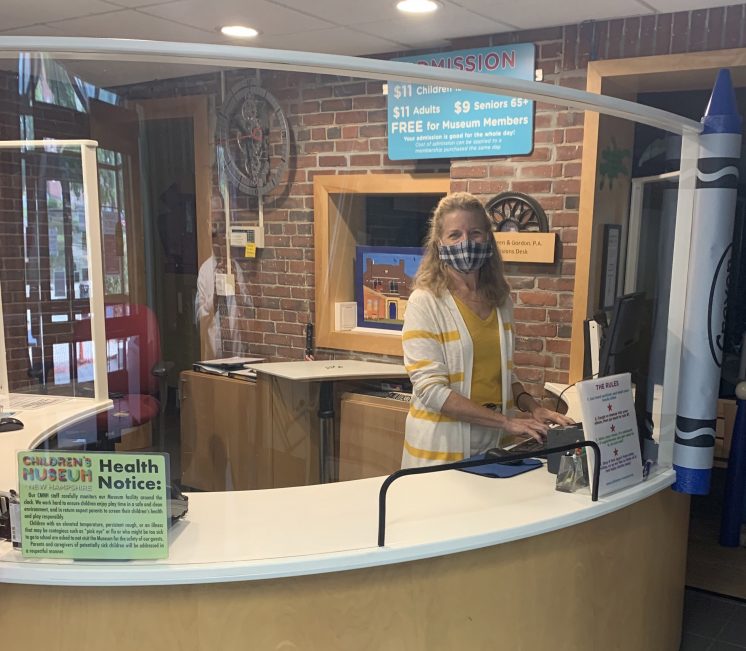
We are excited to announce our reopening to the public in September after a nearly six-month closure due to COVID-19. “During this unprecedented time of stress and hardship, we hope that reopening the Museum brings joy and a hint of normalcy to the lives of children, families and the community,”said Jane Bard, Museum President. “We recognize that there is still much uncertainty, and that some families might not be ready for in-person experiences like visiting a Museum. For those families, we are committed to continue offering virtual programming and learning resources through our social media channels,” said Bard. “For families ready to return, we look forward to welcoming you back!”
The Museum’s plan for reopening is a phased approach, and initially CMNH will open to their members only on Thursday – Saturday, September 3rd - 5th, and two timed-ticket entry sessions each day from 9 am - 11:30am and 1pm - 3:30 pm. Maximum occupancy for each session will be capped at 50 visitors, which is 10% of CMNH’s building capacity. All visitors must pre-register for their visit online. Online registration can be done one week in advance. Beginning in October, the Museum plans to offer two-hour private Museum rentals to groups of up to 50 people on Sundays.
“As we prepare to open our doors, we feel it is important to share the steps we are taking to keep our guests and employees safe,”said Bard. “We’ve always taken pride in providing a safe, clean, and accessible environment. During our closure, we’ve been preparing to reopen implementing best practices set forth by the Centers for Disease Control and Prevention, the Association of Children’s Museums, and the New Hampshire Reopening Guidelines.”
These safety guidelines include:
- Physically distancing - There are occupancy limits posted for each exhibit, (usually one family at a time), floor decals and dinosaur footprints guiding visitors on the one-way flow of traffic around the Museum.
- Face coverings - All visitors over the age of 24 months and all staff must wear a face covering over their mouth and nose at all times in the Museum. We will offer a once-monthly after-hours session for visitors who cannot wear a mask due to medical reasons. For September that date and time is Sunday, September 27th from 10am-noon. If you wish to visit during that date/time, please email neva@childrens-museum.org.
- Frequent hand washing and sanitizing - The Museum has 17 hand-sanitizing stations and 12 sinks for hand-washing spaced throughout the building.
- Ventilation - we have increased the air rate of exchange in our building to maximum levels and will keep windows open when possible to maximize air flow
- Cleaning and disinfecting surfaces - Museum staff will perform a deep clean in between each timed sessions, disinfecting all surfaces and replacing all exhibit props with a new sanitized set. Some exhibits have been modified and items that are difficult to sanitize or that touch a visitor’s face or head have been removed. Disinfectant wipes will be placed strategically around the Museum for visitor use, and staff will continually clean high-touch surfaces during the day.
- Staying home if you are sick - The Museum asks that all visitors and staff stay home if they are sick or experiencing any symptoms associated with COVID-19. We are happy to reschedule visits if necessary. All Museum staff will answer health screening questions and take their temperature prior to each work day.
IMLS "Inspire!" Grant Awarded to CMNH
The Children’s Museum of New Hampshire (CMNH) in Dover has been awarded a grant in the amount of $47,182 from the Institute of Museum and Library Services (IMLS) to support a pilot project Advancing Play-Based Learning in New Hampshire, a series of educational initiatives designed to help kindergarten teachers and parents implement Play-Based Learning activities in children’s early education. CMNH was the only children’s museum in the tri-state (NH/ME/MA) area to receive this highly competitive grant.
The Advancing Play-Based Learning in New Hampshire (APLNH) project will strengthen early learning as well as provide educators with the skills they need to be successful in implementing Play-Based Learning models in the classroom, required for all kindergarten’s in New Hampshire since 2018. In a recent survey of kindergarten teachers conducted by the University of New Hampshire’s Department of Human Development and Family Studies—a CMNH partner in this project—together with the New Hampshire Department of Education, over 85% of the respondents wanted more professional development opportunities pertaining to Play-Based Learning.
“The staff of CMNH are highly practiced in using Play-Based Learning within museum exhibits and classes,” says Jane Bard, CMNH President. “As experts in early childhood education, CMNH is well positioned to fill the gap in providing kindergarten teachers with solid instructional training in Play-Based Learning.”
The grant will support numerous activities including the production and distribution of a series of instructional videos, professional development workshops, family and educator open houses and subsidized educator-led play based curriculum programs at Title 1 schools. As CMNH has done with all programs, implementation plans will be adapted as necessary in order to continue to serve NH children and families during the pandemic.
“In Play-Based Learning children have more active input into what, and how, they learn,” explains Xanthi Gray, Education Director at CMNH. “It allows them to explore, discover, negotiate, take risks, create meaning, and solve problems – all of which help develop literacy, numeracy and social skills. But it requires the teacher to be highly skilled in facilitating and implementing Play-Based Learning.”
To learn more about Play-Based Learning initiatives or other programs and resources at the Children’s Museum of New Hampshire, visit this page.
FoodWorks: Healthy Frozen Treats
Foodworks is such a fun program that we host at The Children’s Museum of New Hampshire. It promotes healthy eating, families cooking together, and delicious food that you can find at your neighborhood Hannaford!
Today we are sharing two recipes for summer time treats: Frozen Yogurt Bark and Frozen Watermelon Popsicles. Both recipes are easy to make, and are perfect cold treats for hot summer days! Summer is a great time to enjoy ice cream and popsicles, but these two recipes offer a slightly lower sugar and lower fat way to enjoy a cold dessert, and could easily be added to your summer frozen dessert routine, which we all need when it's this hot outside!
Both of these recipes only require a freezer to complete, and both are kid-friendly, so if you have eager kitchen helpers in your family, this is a great way to include everyone in some no fail cooking fun. Also, you do not need popsicle molds to make the Watermelon Popsicles!
If you want to try both recipes, it may be easier to make the yogurt bark first because the watermelon can get messy, and may be easiest to do outside. If you opt to use cookie cutters for the watermelon recipe it results in some extra pieces that need to be eaten, so this activity can double as a snack time.
First - gather your ingredients
For the frozen watermelon popsicles:
- Watermelon- If you need a smaller portion, try the pre-cut watermelon at Hannaford
Skewers, chopsticks, or popsicle sticks - Cookie cutters
For the yogurt bark:
- Plain yogurt
- Vanilla yogurt
- Optional: coconut or soy based yogurt
Optional toppings:
- Berries
- Granola
- Chocolate Chips
- Jam
- Cereal
For both:
- Wax paper
- Pan or tray
- Freezer space
Yogurt Bark Directions:
- Prep your pan or tray by putting down a sheet of waxed paper and a quick spray of cooking oil.
- In a mixing bowl, combine 1 cup of plain and 1 cup of vanilla yogurt to create a lower sugar, kid-friendly version of the bark, or simply choose a yogurt flavor you know your family will enjoy
- Add in any toppings you would like to add
- You can add the toppings to the yogurt once it’s on the tray if you would like to make some bark with toppings, and some plain
- Use a spoon or spatula to carefully add the yogurt to the waxed paper on the tray
- Place the tray in the freezer for about 4 hours or overnight
- Break up the bark to serve. You can save it in a freezer safe container.
Notes: we tried making the bark with soy based yogurt, and coconut based yogurt, both froze well, and were easy to break up and serve. We used Greek yogurt, and it made a tart treat, but be sure to use any yogurt that your family prefers. The Greek yogurt was nice and thick, so it froze well, but any yogurt should work! Please keep in mind that some of the toppings, like the berries, may create a greater risk of choking when frozen, so be sure to supervise as needed. Recipe inspired by Stonyfield Yogurt: Stonyfield Yogurt Bark Recipe
Frozen Watermelon Popsicle Directions:
- Prep a pan or tray with waxed paper
- Cut watermelon into slices- about the same thickness as you would serve to eat fresh
- If children are helping, set each person up with a work station- a cutting board or tray with waxed paper works well
- Use cookie cutters to press the watermelon into desired shape (we made stars, triangles, and circles), and remove seeds with a skewer or toothpick
- Carefully add a stick using a skewer (can be sharp), chopstick, or popsicle stick
- Place each popsicle on the lined tray and place in the freezer
- The extra watermelon scraps can be eaten as snack
- Serve any time you want a healthy refreshing treat!
Notes: This may be the easiest recipe ever aside from a little messy watermelon juice. Creating shapes with cookie cutters is completely optional- you can simply put the watermelon onto the skewer with the rind if you would like. The texture of the watermelon works really well as a frozen treat! It is very similar to the texture of an ice pop- easy to take a bite, though quite cold when it first comes out the freezer. If you opt to use popsicle sticks, use the wooden, un-dyed sticks. Colorful craft sticks tend to bleed the dye when wet, and it may not be food safe! We experimented with adding some melted chocolate chips over a few of the watermelon slices, and it tasted great, but was just a little messier to eat. Recipe reference: https://www.chopchopfamily.org/recipe/frozen-watermelon-popsicles/
We hope you enjoy these refreshing summer treats, and stay cool! Thank you to Hannaford for sponsoring our Foodworks program at CMNH!
Play Patio Construction Begins!
The Children’s Museum of New Hampshire has begun construction on its outdoor Play Patio expansion. The new Play Patio is designed to be an extension of the Museum experience that children, families and educators have grown to love. This three-season outdoor space facing Henry Law Park will feature messy materials and activities such as an oversized paint wall, ramps and chutes for water exploration, sensory tables for mud and bubble fun, color shadows, clay play and more. Plans for the Play Patio were unveiled during the Museum’s 35th anniversary in 2018 and the project was funded before the museum temporarily closed due to COVID-19 in mid-March.
“We love open-ended exploration, but without an outdoor space, it’s difficult to offer it consistently,” shared Children’s Museum of New Hampshire President Jane Bard. “With this new Play Patio space, we’ll be able to incorporate messy play with our other more traditional hands-on exhibits, offering yet another level of discovery to our visitors. This project has been over two years in the making, and we’re excited that, despite the challenges of the pandemic, we’re creating a place to bring joy to children and families during a time that they need it the most,” said Bard. “People may have noticed the construction crews converging at the front of the museum and this is why. Construction so far has involved extending and creating drainage, cementing over open basement windows in the building, removing the existing asphalt and fence and starting to install a lightweight block material called Geofoam to fill-in the entire space. Many of the exhibit components have been built and we will be installing a playground surfacing material in September.
The museum’s Play Patio does not have an open date as of yet.
The Play Patio project is made possible thanks in part to the $100,000 tax credits the museum received from the NH Community Development Finance Authority. Businesses who purchased those tax credits include Highland Hardwoods, BankKW Staffing, LLC, Northway Bank, Newburyport Bank, First Seacoast Bank, DF Richard, Stinson Associates, Leone, McDonnell & Roberts, and Seacoast Endodontics. Other sponsors include Kennebunk Savings Bank, Newburyport Bank and Wentworth-Douglass Hospital. Grants for the project have been provided by the Abbie F. Moseley Charitable Trust, the McIninch Foundation, the Samuel P. Hunt Foundation, the Roger R. & Theresa S. Thompson Endowment Fund, and the Jack & Dorothy Byrne Foundation.
The Children’s Museum of New Hampshire will continue to share updates and photos of the Play Patio progress on its social media pages.
Museum Summer Update
Happy summer Museum fans! We wanted to give you an update on the Children’s Museum and where we are at in terms of reopening. The short answer is, we are not opening yet. We have studied the latest guidelines for the reopening of Museums and are working diligently to adapt our facility, exhibits, cleaning and safety procedures to meet and exceed these guidelines. Our top priority is to keep our visitors and staff safe. We are taking your comments and suggestions from our recent survey under advisement and are confident that when we do reopen, it will be as safe as possible for all involved, and still feel like the museum you know and love.
In the meantime, we encourage you all to continue to support our mission of actively engaging families in hands-on discovery with a purchase of a “Stay and Play Summer Camp Kit.” We sold out our first round of kits and they are back on sale now to be be available for pick-up in July at the museum! The Discovery Camp kits are for ages 6-10 and the Wee Kits are for ages 3.5-5. And then we are continuing to offer our “Community Builder” option, where you can purchase either kit for yourself and donate one to a child in need - or donate both - whatever suits your situation. We connect with local partner organizations to identify families who may greatly benefit from an activity kit this summer. So far we’ve been able to donate kits to 15 families thanks to your generosity!
Another way to support our work is to purchase a Car or Cash Raffle ticket for $100! We’ve extended the sale through the end of August. Only 725 tickets will be sold and one lucky winner will be announced on August 29th and can choose between a black 2020 Nissan 370Z coupe (MSRP $35,215) or a metallic grey, 2020 Nissan Leaf S model 100% electric car (MSRP $34,610) or $20,000 cash!
And of course a Membership to the Museum makes a wonderful gift for any family! Please remember, all Children’s Museum of New Hampshire members will have their membership extended by the number of months we are closed.
Stay positive and healthy and we will see you soon.
First Friends at Home: More Favorites
By Meredith Brustlin, CMNH Educator
As this was our last First Friends Friday/Baby Storytime for the school year...I focused on favorites!
Hello Song:
Hello it’s time to play
Let’s have some fun today!
Let’s clap our hands
And wiggle our toes
A hug...and a kiss...and away we go!
Hello (insert name here) it’s time to play
We’ll have so much fun...hooray!
Open Them/Shut Them (action song)
Open them, shut them
Open them, shut them
Give a little clap-clap-clap
Open them, shut them
Open them, shut them
Lay them in your lap-lap-lap
Creep them, creep them, creep them, creep them
Right up to your chin-chin-chin
Open up your little mouth…
But do not let them in!
My Little Red Wagon (bounce)
Bouncing up and down in my little red wagon
Bouncing up and down in my little red wagon
Bouncing up and down in my little red wagon
Won’t you be my darling?
Bouncing side to side in my little red wagon
Bouncing side to side in my little red wagon
Bouncing side to side in my little red wagon
Won’t you be my darling?
Bouncing way up high in my little red wagon
Bouncing way up high in my little red wagon
Bouncing way up high in my little red wagon
Won’t you be my darling?
Slowly, Slowly (action rhyme/tickle)
Slowly, slowly, very slowly
Creeps the garden snail
Slowly, slowly, very slowly
Up the wooden rail
Quickly, quickly, very quickly
Runs the little mouse!
Quickly, quickly, very quickly
All around the house!
Teddy Bear, Teddy Bear (action song)
Teddy bear, teddy bear, turn around
Teddy bear, teddy bear, touch the ground
Teddy bear, teddy bear, reach up high
Teddy bear, teddy bear, touch the sky!
Teddy bear, teddy bear, show your shoe
Teddy bear, teddy bear, I love you!
Teddy bear, teddy bear, slap your knees
Teddy bear, teddy bear, sit down please.
Popcorn (prop song)
Popcorn, popcorn (Wave your scarf!)
Popcorn, popcorn
In the pot, in the pot (Hide your scarf in your hands)
Shake them, shake them, shake them (shake shake shake!)
Shake them, shake them, shake then
‘Til they pop! ‘Til they pop! (Throw scarf in the air!)
Scarf Peekaboo (prop song)
We wave our scarves together
We wave our scarves together
We wave our scarves together
Because it’s lots of fun!
We wave them up high!
We wave them down low
We wave them over you...peekaboo!
Because it’s lots of fun
We throw our scarves together
We throw our scarves together
We throw our scarves together
Because it’s lots of fun!
We throw them up high!
We throw them down low
We throw them over you...peekaboo!
Because it’s lots of fun!
Goodbye Rhyme (action rhyme)
This is big, big, big
And this is small, small, small
This is short, short, short
And this is tall, tall, tall!
This is fast, fast, fast
And this is slow, slow, slow
This is yes, yes, yes
And this is no, no, no
This is hi, hi, hi
And this is bye, bye, bye!
First Friends at Home: Our Favorites!
By Meredith Brustlin, CMNH Educator
This week I shared some tried and true Baby Storytime favorites! I hope you enjoy!!
Hello Song:
Hello it’s time to play
Let’s have some fun today!
Let’s clap our hands
And wiggle our toes
A hug...and a kiss...and away we go!
Hello (insert name here) it’s time to play
We’ll have so much fun...hooray!
Open Them/Shut Them (action song)
Open them, shut them
Open them, shut them
Give a little clap-clap-clap
Open them, shut them
Open them, shut them
Lay them in your lap-lap-lap
Creep them, creep them, creep them, creep them
Right up to your chin-chin-chin
Open up your little mouth…
But do not let them in!
Sugar Babies (action rhyme)
Roll, roll sugar babies
Roll, roll sugar babies
Push! Pull! Clap-clap-clap!
“ “
Hot! Cold! Clap-clap-clap!
“ “
Up! Down! Clap-clap-clap!
Little Bird (action song/bounce)
Tune: Twinkle, Twinkle Little Star
I saw a little bird go hop-hop-hop
I asked that little bird to stop-stop-stop
I went to the window to say: How do you do?
He wagged his little tail at me and away he flew!
Popcorn (bounce)
Popcorn, Popcorn
Sizzling in the pan
Shake it up, shake it up
Bam! Bam! Bam!
Popcorn, Popcorn
Now it’s getting hot
Shake it up, shake it up
Pop! Pop! Pop!
Colors in the Air (prop song)
Colors, colors
Colors, colors
Floating in the air!
Floating in the air!
Red, Orange, Yellow
Green, Blue, Purple
Floating in the air!
Floating in the air!
Goodbye Rhyme (action rhyme)
This is big, big, big
And this is small, small, small
This is short, short, short
And this is tall, tall, tall!
This is fast, fast, fast
And this is slow, slow, slow
This is yes, yes, yes
And this is no, no, no
This is hi, hi, hi
And this is bye, bye, bye!




